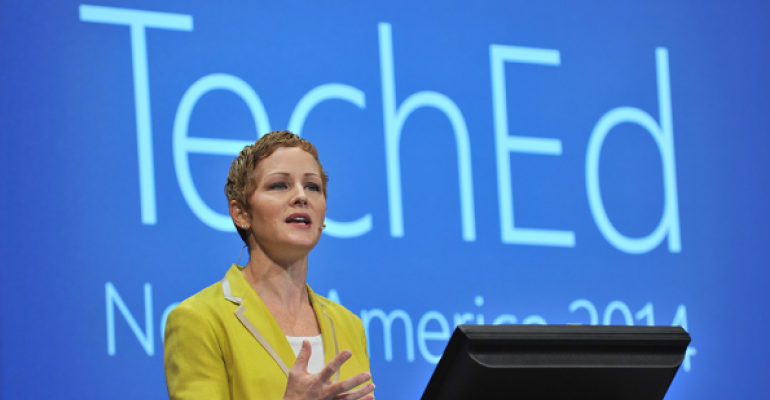At the Microsoft TechEd 2014 conference that was held in Houston earlier this month, SharePoint Pro editors had the chance to meet with Julia White, General Manager of the Microsoft Office Division. Given her expertise and involvement with the Office division, we had some questions regarding Microsoft's overall strategy for its Office services. Read on for Julia White's thoughts on how Microsoft is bringing better collaboration and productivity to its Office 365, SharePoint, OneDrive, and Yammer offerings.
SPP: You've said in a recent eWeek article that business intelligence and big data analytics is "not in the hands of data wonks anymore." Do you see that democratization, if you will, happening in the area of SharePoint/SharePoint Online/Office 365 in the future?
JW: The user experiences traditionally aligned with SharePoint are increasingly getting more and more accessible or "democratized". Take team collaboration –- today any user can share content from their OneDrive for Business account or create a Yammer group to discuss a topic -– no special tech skills involved, nor IT involvement required. Even a small change we are making with Outlook where, upon selecting 'add attachment', users are prompted with the option to either attach the content or post it directly to OneDrive for Business to share and anyone on the email gets permissions to the content -– makes collaboration brain dead easy for even the least sophisticated user.
Or, something like creating a simple project plan, we have Project Lite that is for the 'average person' versus a project management specialist. In a bunch of areas, you are seeing Office 365 become more and more accessible to all types of users. Much of this can be attributed to Office 365 being delivered via the cloud where we can create very integrated, seamless user experiences because everything is integrated on the back end -– and for something like Power BI or OneDrive for Business -- there is massive compute power and storage to tap into. When you're not worried about how different puzzle pieces of Servers and Clients can all fit together, you can instead focus on creating absolutely amazing and accessible user experiences.
SPP: Do you have any tips on how to integrate Yammer successfully into an employee's typical and daily work life?
JW: We find the most natural way employees are using Yammer in day-to-day work is communicating all team-level information there by default. Most people continue to use email for 1:1 and 1:few communications, but for broader communications and discussions Yammer is super effective to both better disseminate information and enable faster decision making by connecting dots across the team quickly. In essence, the moment you have a fluid group of people trying to coordinate their work, Yammer's a great option. There is also integration between Yammer and email, such that a hard-and-fast email user can keep up on Yammer discussions via email notifications.
SPP: What prepared you in life for working at Microsoft and for standing in front of 10,000 SharePoint people or 8,000 IT pros and devs at Microsoft events and demoing products?
JW: I'm not sure anything prepares you for your first demo in front of 10K people, but each one certainly gets easier. That said, I was a competitive synchronized swimmer from age 9 through college. Performing my synchronized swimming routines in front of hundreds, and sometimes thousands, of people is a useful on-ramp to keynote demos. At least in Microsoft keynotes, I’m not wearing a swimsuit covered in sequins. :) I would also be remiss not to mention that I have had great people coaching me and giving me feedback on my presentation skills over the years, so all about practice and investing the time to get to a place where I really enjoy it.
SPP: Our own Paul Thurrott has written on Windows IT Pro, "But it is in this devices and services world, I think, that Office is taking its boldest steps. And while Microsoft can't map everything it makes to the same model, what the teams responsible for Office are doing should be studied and adapted where possible all over Microsoft." Where at Microsoft do you see the potential for the most success should another team or division at Microsoft choose to emulate what the Office team has done?
JW: If I look at the work that the Cloud and Enterprise team (formerly Server and Tools) is doing, I would say they are successfully emulating what you’ve seen Office do -– both in terms of our cloud strategy and x-vendor support. Investments in Azure, Power BI for Office 365 and Intune are great cloud offerings that are innovating fast and providing holistic, integrated solutions to customers. Additionally, Cloud and Enterprise is working openly across the industry with things like the Oracle partnership with Azure, Intune management support for Android and iOS devices and integrating with all forms of data within the BI tools. I see both Office and the Cloud and Enterprise teams working in very aligned ways now – each group in a unique phase of this journey, but being successful in their own right.
SPP: Many see the act of putting Office on the iPad as a big deal. Was there any discussion between divisions as to whether this might cause ramifications for the Surface Pro?
JW: We absolutely considered the overall company impact of Office for iPad apps. The decision to launch these apps was made in a One-Microsoft way with input from leaders across the company. Ultimately, we concluded that this was the right decision for the company and the right time for us to launch these apps.
SPP: Thanks so much for your time, Julia! We know that our readers will find your thoughts valuable!
See "TechEd North America 2014: New Azure Features Aim to Put IT Pros' Trust in the Cloud" and "TechEd 2014: Protect Your Data in SharePoint Online and OneDrive for Business" for more information emerging from the TechEd 2014 conference.





